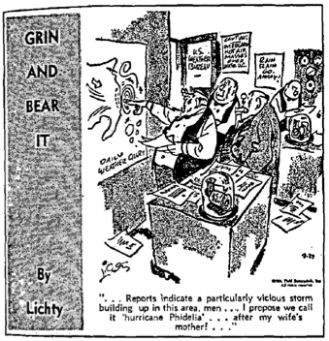Women’s names have been used for Atlantic hurricanes since 1953, but the practice had always been controversial. In 1978, the responsibility for the name lists was transferred from the U.S. Government to delegates of the World Meteorological Organization’s Region IV Hurricane Committee. The Carter Administration, in response to pressure from feminist groups, requested the Committee adopt the Australian custom (adopted in 1975) to include male as well as female monikers. Since the Atlantic hurricane name list had already been adopted for that year the change over for the Atlantic was initiated in 1979.
Two of the most notable hurricanes that year bore men’s names, David and Frederic. So both names were retired after their first use.
1979 Atlantic Hurricane Names
Ana Henri Odette
Bob Isabel Peter
Claudette Juan Rose
David* Kate Sam
Elena Larry Teresa
Frederic* Mindy Victor
Gloria Nicholas Wanda
*retired
The laboratory that is now HRD flew missions in three of the systems, all male-named, during the year. Click on the links for more information on the flights. A good number of studies came out of these missions, including:
Bell, K and P. S. Ray. 2004: North Atlantic Hurricanes 1977-99: Surface Hurricane-Force Wind Radii. Mon. Wea. Rev., 132, 1167-1189.
Black, P. G., R. W. Burpee, N. M. Dorst, and W. L. Adams, 1986: Appearance of the Sea Surface in Tropical Cyclones. Wea. Forecast., 1, 102-107.
Croxford, M., and G. M. Barnes, 2002: Inner Core Strength of Atlantic Tropical Cyclones. Mon. Wea. Rev., 130, 1, 127-139.
Frank, W. M. 1984: A Composite Analysis of the Core of a Mature Hurricane. Mon. Wea. Rev., 112, 2401-2420.
Jorgensen, D. P., and P. T. Willis, 1982: A Z-R Relationship for Hurricanes. J. Appl. Meteor., 21, 356-366.
Jorgensen, D. P., 1984: Mesoscale and Convective-Scale Characteristics of Mature Hurricanes. Part I: General Observations by Research Aircraft. J. Atmos. Sci., 41, 1268-1286.
Jorgensen, D. P., E. J. Zipser, M. A. LeMone, 1985: Vertical Motions in Intense Hurricanes. J. Atmos. Sci., 42, 839-856.
Kaplan, J., and W. M. Frank, 1993: The Large-Scale Inflow-Layer Structure of Hurricane Frederic (1979). Mon. Wea. Rev., 121, 3-20.
Powell, M. D., 1982: The Transition of the Hurricane Frederic Boundary-Layer Wind Field from the Open Gulf of America to Landfall. Mon. Wea. Rev., 110, 1912-1932.
Rodgers, E.B., R. Mack, A. F. Hasler, 1983: A Satellite Stereoscopic Technique to Estimate Tropical Cyclone Intensity. Mon. Wea. Rev., 111, 1599-1610.
Samsury, C. E., and E. J. Zipser, 1995: Secondary Wind Maxima in Hurricanes: Airflow and Relationship to Rainbands. Mon. Wea. Rev., 123, 3502-3517.
Shapiro, L. J., 1983: The Asymmetric Boundary layer Flow Under a Translating Hurricane. J. Atmos. Sci., 40, 1984-1998.
Shay, L. K., and R. L. Elsberry, 1987: Near-Inertial Ocean Current Response to Hurricane Frederic. J. Phys. Ocean., 17, 1249-1269.
Shay, L. K., S. W. Chang, and R. L. Elsberry, 1990: Free Surface Effects on the Near-Inertial Ocean Current Response to a Hurricane. J. Phys. Ocean., 20, 1405-1424.
Szoke, E. J., E. J. Zipser, and D. P. Jorgensen, 1986: A Radar Study of Convective Cells in Mesoscale Systems in GATE. Part I: Vertical Profile Statistics and Comparison with Hurricanes. J. Atmos. Sci., 43, 182-198.
Willoughby, H.E., J. A. Clos, and M. G. Shoreibah, 1982: Concentric Eye Walls, Secondary Wind Maxima, and The Evolution of the Hurricane vortex. J. Atmos. Sci., 39, 395-411.
Willoughby, H. E., F. D. Marks, and R. J. Feinberg, 1984: Stationary and Moving Convective Bands in Hurricanes. J. Atmos. Sci., 41, 3189-3211.
Willoughby, H .E., D. P. Jorgensen, R. A. Black, and S. L. Rosenthal, 1985: Project STORMFURY: A Scientific Chronicle 1962-1983. Bull. Amer. Met. Soc., 66, 505-514.
Willoughby, H .E., 1990: Temporal Changes of the Primary Circulation in Tropical Cyclones. J. Atmos. Sci., 47, 242-264.
